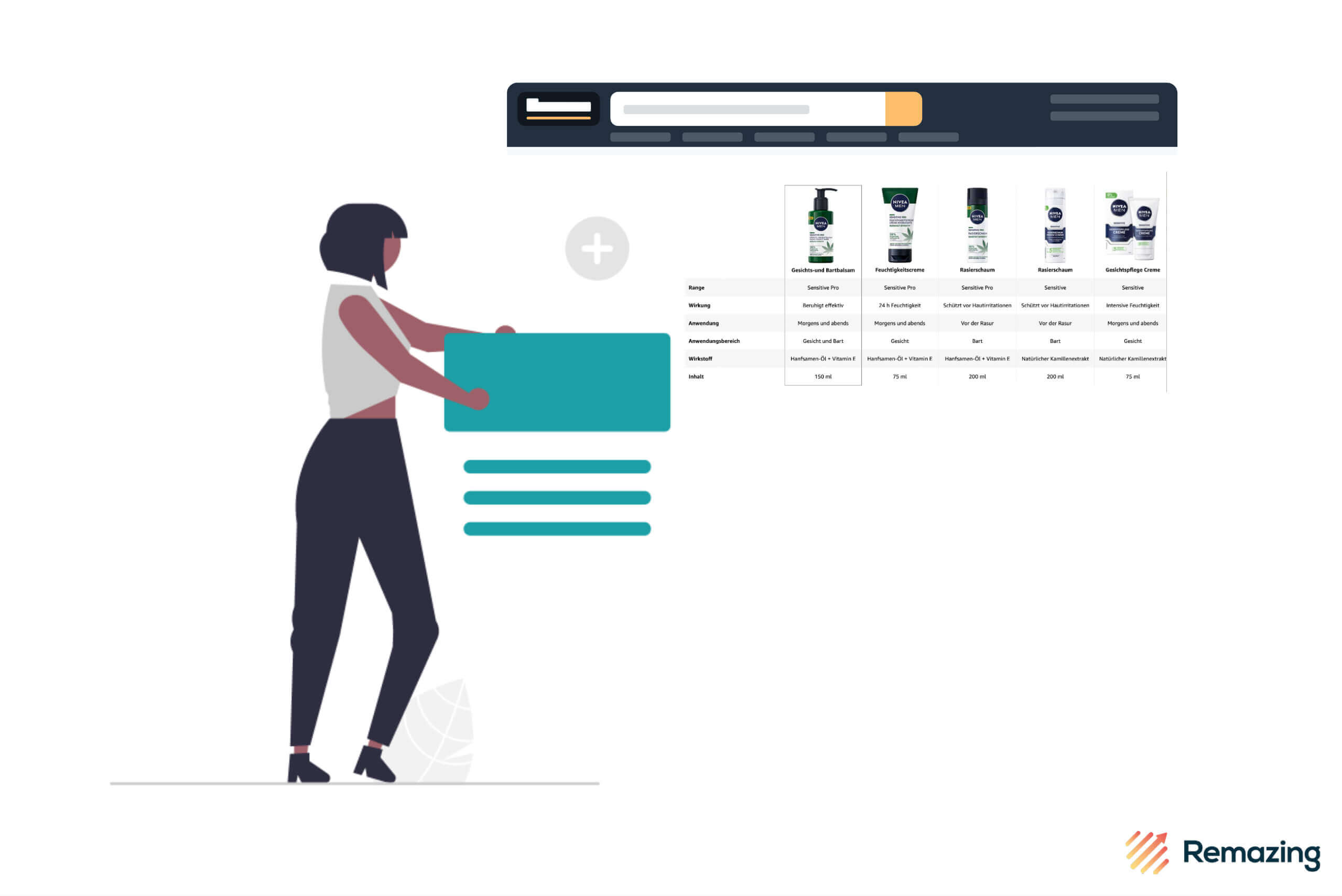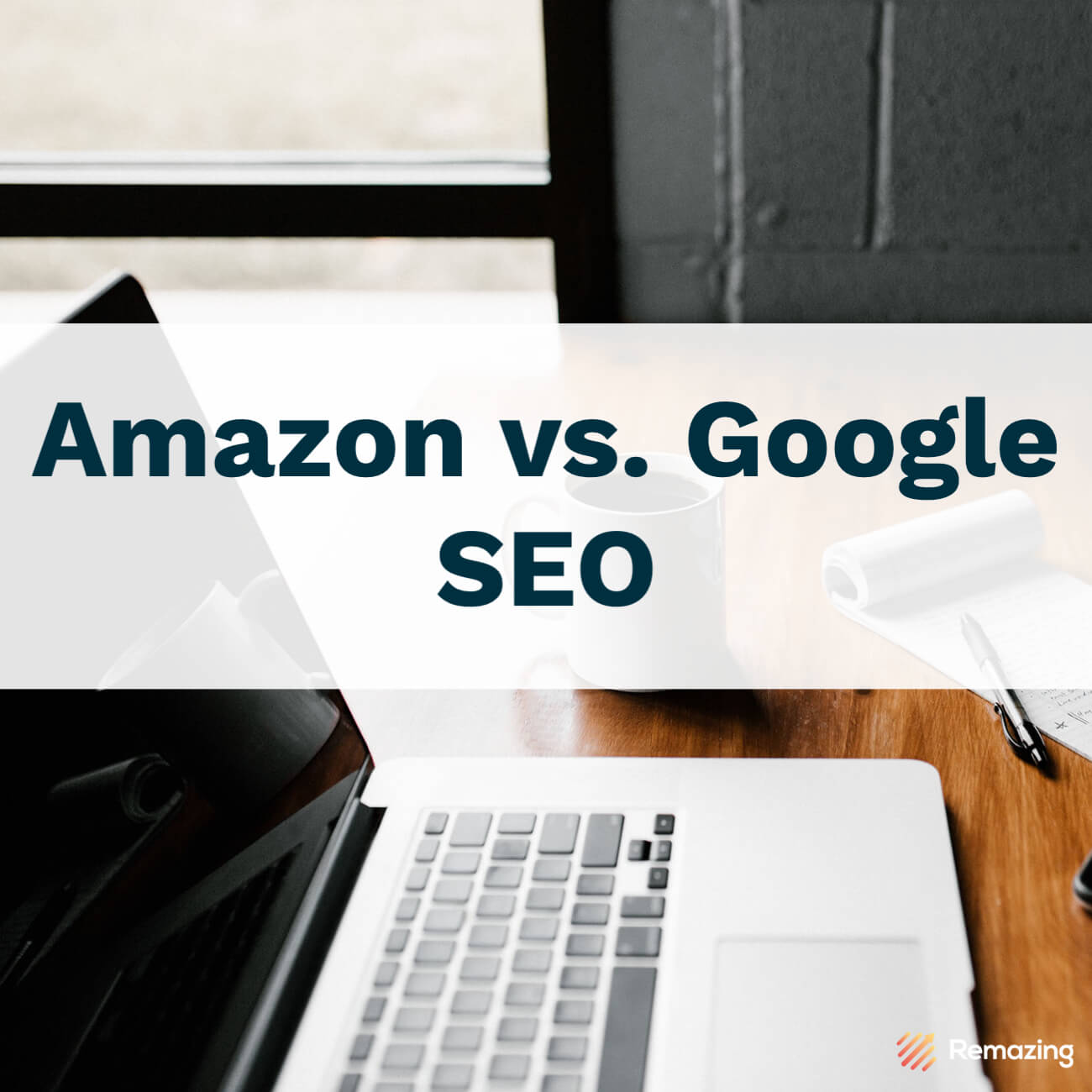
Amazon SEO vs. Google SEO

Whoever is at the top wins – this applies to both Google and Amazon. Only the way up is different in some points.
Why does Amazon SEO work differently than Google SEO?
Alignment is crucial
Google is a horizontal search engine. In terms of their users, this primarily means that their search intent isn’t limited to buying. Someone who googles for “washing machines” may want to buy one, but may also want to find out what the latest technology is or is looking for a local specialist dealer.
In the buying process, Google is located in the mid-funnel: the phase in which the customer is already interested but still wants to find out more.
As a vertical search engine, Amazon is more in the lower funnel, the buying phase. Although the platform is increasingly being used for earlier steps in the buying process, there is still a clear intention to buy behind every search query. Against the background of this different starting situation, there are clear differences in the “way of thinking” between Google’s and Amazon’s algorithm.

The Google and Amazon algorithms – what do we know about them, what do they know about us?
Since Amazon is a closed marketplace and Google is a universal search engine, the success metrics that are important for the algorithm also differ. For example, the user experience or page experience has a decisive influence on the Google ranking, as the company itself announced in 2020. This can be measured using various KPIs. This includes the bounce rate (the number of users who leave a page immediately), returning visitors, session duration, etc. The key figures for evaluating these indicators are very complex and differ depending on the search intention. Regardless of the search intention, the click-through rate (CTR) of ads and organic listings can be used to assess the relevance of the search result.
The Amazon algorithm A9 decides in a much more direct way whether a product is relevant to a search query. For example, if a customer searches for a “spice rack” and then buys a product, Amazon knows that the product matches this search query. Amazon not only knows the click-through rate, but it also knows the conversion rate and sales of a listing and has a lot of information about the user, such as previous purchases. Since the intention to buy on Amazon is always given, the conversion rate and after that the click-through rate are important KPIs.
In practice, however, one of the most serious differences between the Google and Amazon algorithms is that there is much more information about the former: There are numerous books, guides and experts for Google SEO and SEA. Also, Google offers numerous tools, as for researching keywords and monitoring your performance. The best known and most popular include Google Analytics and the Search Console. In particular, when it comes to product performance tracking, the offer for Amazon SEO is much thinner. To make our work as an Amazon SEO agency as effective as possible, we have therefore developed our own tool Remdash, with which we can monitor the content and performance of listings and react in an agile manner.
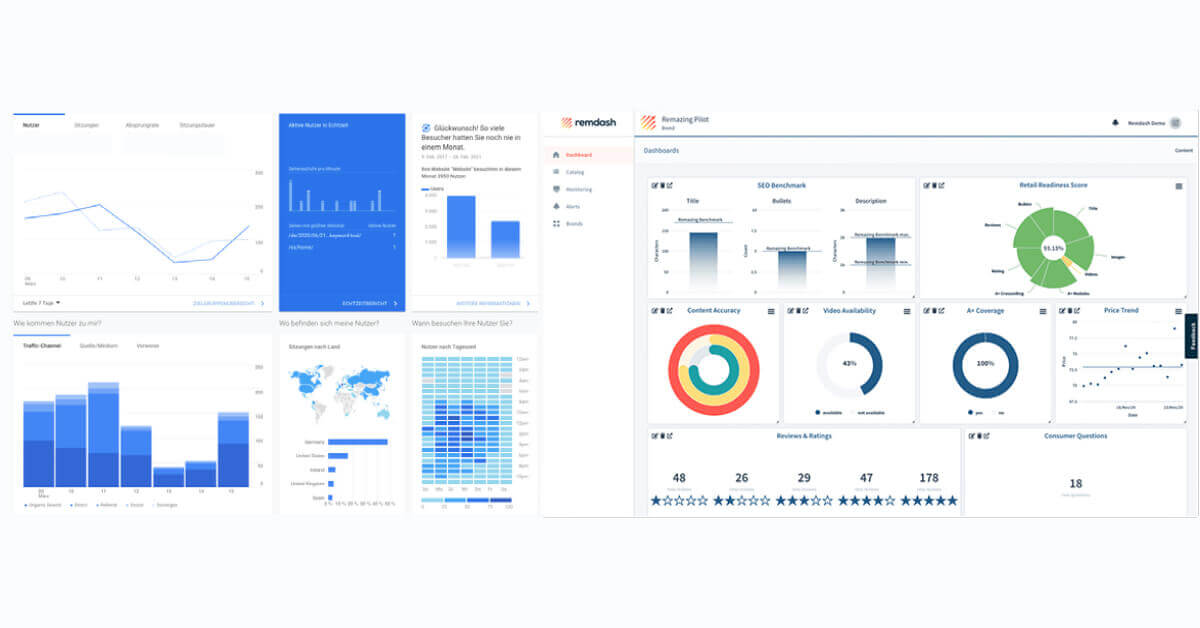
Factors for a successful Amazon and Google ranking
Advertising and organic ranking
What both platforms have in common: The first places on both search results pages are occupied by paid listings. Typically, all entries are “above the fold” ads, so the user has to scroll down to see organic results. Another thing they have in common: Ads are not easily recognized as such at first glance if you don’t know exactly what to look out for. In a survey we conducted, 35.4% on Google and even 41.3% on Amazon did not recognize the paid content in the example. In particular with Amazon, the reference is limited to a barely visible, grey “Sponsored” near the product name, while Google puts a bold “Ad” at the beginning.
Ads are not only relevant to the Amazon ranking because they occupy the best positions. In contrast to Google, they also have an indirect influence on organic ranking: For the Amazon algorithm, not only the relevance of a product’s content is important, but also the performance. As mentioned above, CTR and conversion rate are important KPIs for Amazon. The sales generated by sponsored ads thus become a ranking factor for the organic results.
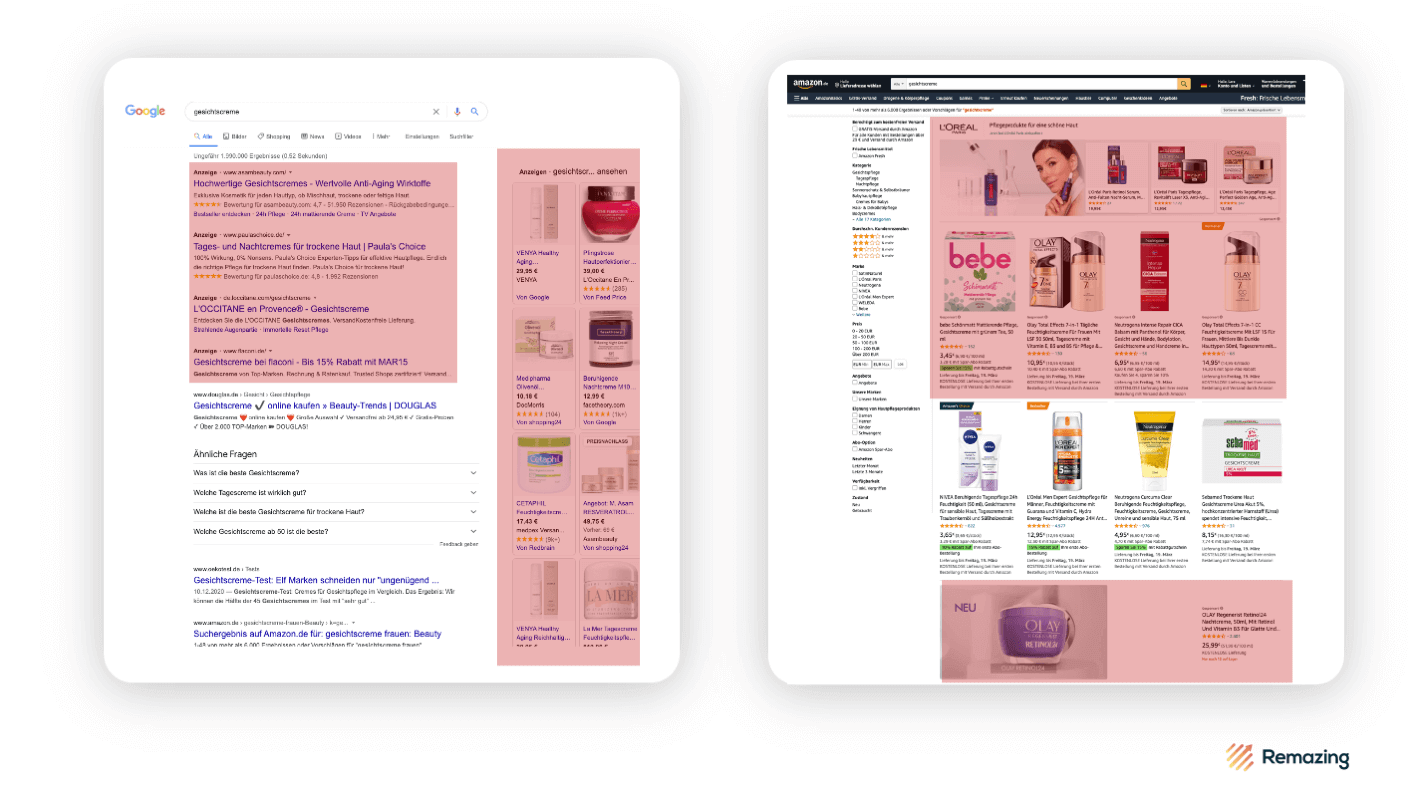
When setting up campaigns, the differences also lie in how sophisticated the strategies and targeting are. Here, too, Amazon is constantly stepping up. For example it is now possible to reach target groups via Sponsored Display Ads Retargeting. We explain how this works and how to develop and set up your own Amazon DSP strategy in our beginner’s guide.
On-page and off-page optimisation
In Google SEO, a classic distinction is made between on- and off-page optimisation. This distinction can also be made with Amazon SEO, whereby the on-page options are limited and the off-page measures only have an indirect effect.
On-page optimisation
On-page optimisations describe the part of SEO that takes place directly on the page and aims to make it easy to find and use.
A clear on-page measure that is possible on both platforms is to include relevant keywords. However, there are differences in content that we will take a closer look at later.
Search engines like Google also prefer well-structured content. This is where we come up against our limits on Amazon, as the structures are fixed. With Google optimisation, the structure of the page is defined in the HTML code. Metadata tell the Google crawler for example the title of the page or whether a particular page should not be indexed or a link should not be followed. Even though the end-user does not see the HTML code, optimisation is also important with regards to this: The meta description contains the most important information about the page, plays it out as a short text under the title of the search result and thus encourages a click. Besides, the structuring of the page with paragraphs and headings (H tags) makes the content easier to understand, which improves the user experience.

Subscribe to our newsletter now and receive regular updates on Amazon and other online marketplaces.
Subscribe to the newsletter now.
A good user experience is of crucial importance on both platforms. On Google it reduces the bounce rate and extends the length of stay, on Amazon it directly influences the conversion – it is therefore relevant for the most important KPIs on the respective platform. While at Google we are free to design and structure our content, we are limited to the given structures and rules on Amazon. It is all the more important that we make full use of all possibilities. Good content that highlights the benefits of the product and makes it quick and easy for customers to grasp, leads to more sales, more positive reviews and thus to a better ranking. In our overview of the perfect Product Detail Page and the step-by-step guide for A + Content, we explain which options there are for content-related and structured optimisation on the Amazon PDP.
Off-page optimisation
The so-called backlinks are one of the most important off-page factors in Google SEO. These are links on external websites that lead to your site and thus indicate their relevance and popularity. However, it is not only the quantity but also the quality of the links that counts. A page with many high-quality backlinks has a high domain authority and is rated as particularly trustworthy by Google.
A Google backlink can also be thought of as a recommendation of one website by another, much like a good review. Because of this commonality, reviews on Amazon are also misleadingly referred to as “the backlinks for Amazon SEO”, since at least their number and quality is a direct ranking factor.
To build backlinks in the course of off page optimisation, there are some legitimate methods such as guest posting, using web directories or simply generating really good content. On the other hand, there are hardly any advisable ways to influence Amazon reviews without violating the guidelines. A direct option is Amazon’s own product tester program Vine, which is available to all sellers on Amazon for a fee.
The possibilities for off-page optimisation on Amazon are more of an indirect nature. However, advertising on external platforms such as Facebook or affiliate links can drive additional traffic to the Amazon listing. If this also leads to purchases, this has a positive effect on the ranking.
Increasing brand awareness through marketing measures can also function indirectly as an off-page optimisation: This generates more searches with branded keywords, which result in a higher click-through rate and conversion. This in turn leads to an improved sales rank, which also has a positive effect on the ranking for non-branded keywords.
Amazon and Google keywords – the right strategy for both platforms
Types of content and targeting
When researching Google keywords, fundamental differences are depending on the orientation of the search intent of the user. The search query can e.g. B. be information-oriented or transaction-oriented, the content and keywords should be aligned accordingly. Information-oriented content includes, among other things. Advice, blog article or magazine article.
A form of content with particularly high SEO relevance is transactional content since search terms from this area often have a high and stable search volume and can thus ensure consistently high organic traffic. Accurate keyword targeting is particularly important here, as the market is very competitive.
At Amazon, there is only transactional content. Since the intention to buy is already given, certain longtails such as “buy a mobile phone cover” are not relevant. Of course, we should also keep our target group in mind here, but we can broaden our range of keywords. Because the Amazon algorithm determines the relevance of a product page not only via the click-through rate but also via the conversion and sales rank. There are now a variety of tools for researching Amazon keywords. However, many of these offer unreliable Google-based data, as our comparison of keyword tools shows.
Quality & Quantity
There are also certain differences when building a keyword set for Amazon and Google. A traditional approach to Google SEO is a keyword set consisting of the main keyword and around three to four secondary keywords, all of which come from the same cluster. Since Google is now getting better and better at understanding text content, it also makes sense to use different variants of a keyword: singular and plural, grammatical variants, synonyms or combinations. Stop words like “for”, “a”, “and” do not prevent the crawler from understanding the keyword. The aim is to use as many topic-related terms as possible without disturbing the legibility of the running text since so-called “keyword stuffing” is punished by Google with a poorer ranking.
The repetition of a keyword does not influence Amazon ranking. If the searched term is included in the content at least once, the product is assigned by the Amazon algorithm and displayed. It is therefore particularly important to pay attention to the great diversity and to cover as many synonyms and long-tail keywords as possible.
Correct placement of keywords
The placement of important keywords should happen in prominent places on both Amazon and Google. In Google SEO, it is assumed that keywords that e.g. are marked by headline tags are recognized as important. In any case, the main keyword should be integrated into the title tag, but at the same time also in other text elements. Secondary keywords should appear in the meta description, in the running text, in subheadings, etc.
At Amazon, too, we place the most important keywords in the headline, not only for the A9 algorithm but also for the end customer, who recognizes his search query immediately. Other important keywords are integrated into the bullet points and finally in the description. Amazon A + Content is not indexed but is relevant for conversion.
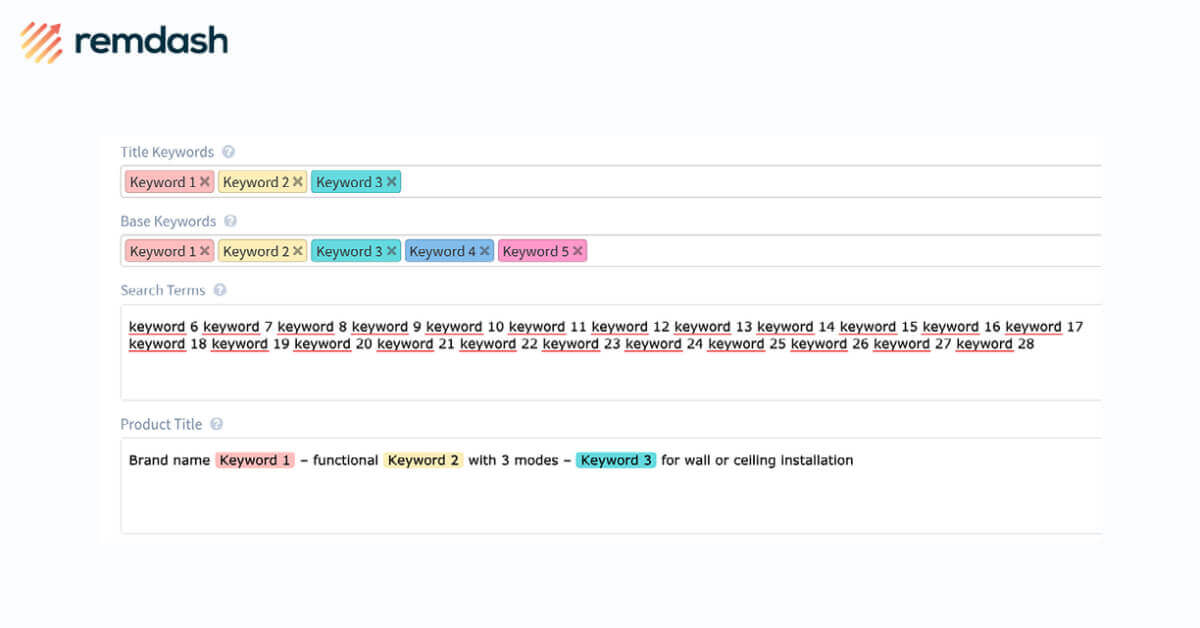
Backend keywords play a special role on Amazon. They are often compared with the meta keywords on Google, but the latter does not influence the organic ranking. The search terms in the Amazon backend are different: they are part of an Amazon optimisation and contain all other important keywords that have not found a place in the frontend.
The following applies to both search engines: Keywords should be integrated into the content in such a way that the text remains legible and sounds natural because, after all, the page should not only please the algorithm, but also the user!
Conclusion
At first glance, the similarities seem more numerous than the differences, but they are all the more serious. While Amazon SEO is still in its infancy compared to Google SEO, the marketplace is becoming more important every day. It is all the more important for retailers to utilise the full optimisation potential on this platform too, because – whoever is at the top wins!
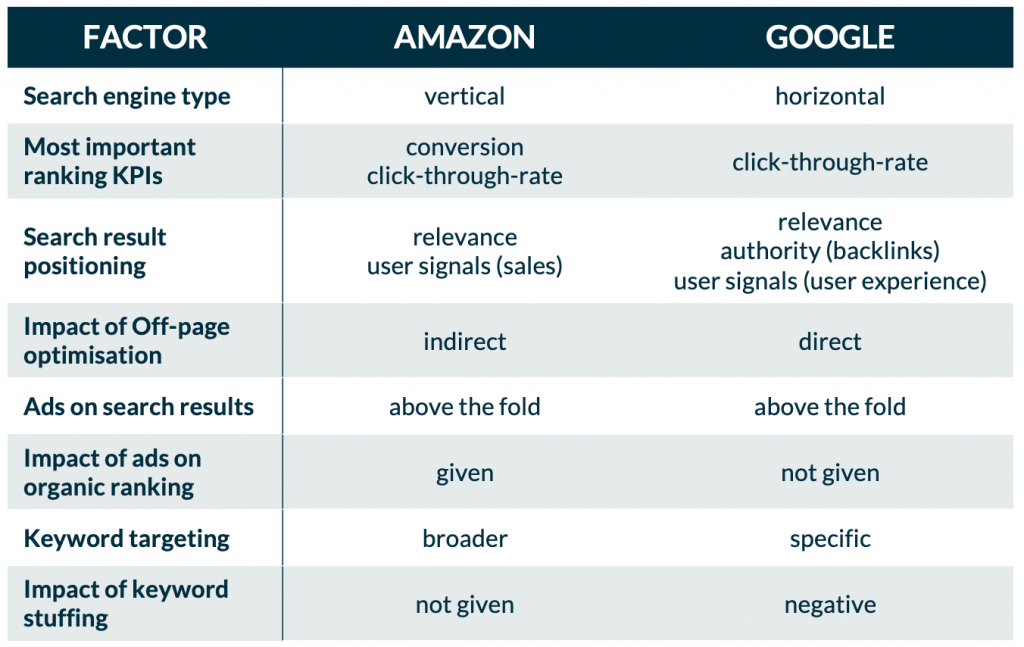
Are you interested in an expert analysis of your Amazon account?
Request free analysisRelated articles
Remazing GmbH
Brandstwiete 1
20457 Hamburg
©Remazing GmbH


